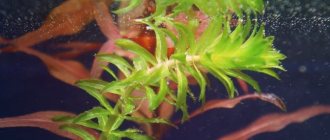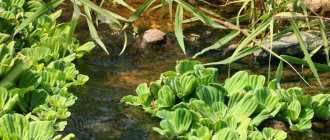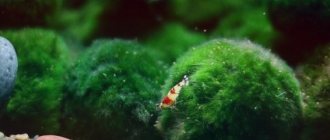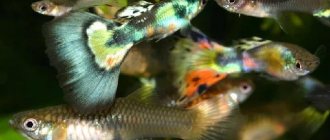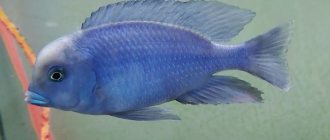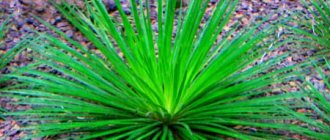The world of aquarium flora contains a huge variety of plants. Some require sensitive care and a lot of experience. Otherwise, you risk creating an uncomfortable living environment for your pets.
Fish live in a confined space, so it is very important to properly organize their environment. One of the most unpretentious plants is Elodea, otherwise called “Water plague” or “Water infection”, which was brought to European shores in the mid-nineteenth century from the United States of America.
Description
The water plague Elodea received its name for its rapid growth and interference with fishing and shipping. In a home pond, the plant does not require special care, improves the free space, serves as a filter, compressor, and refuge for juveniles.
If you meet elodea once, you won’t be able to confuse it with other plants!
Under natural conditions, the thin, climbing stem of water plague reaches two meters. The closer the plant is to the light, the greater the color saturation of the green fine-toothed leaves. The leaf blades are collected in a ring shape, 3 pieces per knot, which is called whorled leaf arrangement. Small, single flowers bloom when thread-like flower stalks growing from the leaf axils reach the surface. The delicate tubular calyx consists of three sepals fused together, colored greenish or reddish. The corolla consists of 3 rounded white petals.
Elodea roots are long, but thin and often poorly developed.
The roots are poorly developed. Elodea can develop in the absence of soil , floating freely in water. The rooted culture spreads along the bottom, produces multiple vertical shoots, forming lush thickets. In an indoor pond, water plague develops evenly regardless of seasonality. In nature, when the temperature drops and there is insufficient lighting, the attractiveness of the appearance is lost. The water plague sinks to the bottom of a pond or lake. As soon as conditions change for the better, new shoots grow from the preserved growth buds.
Benefits for the aquarium
Small species of fish will find shelter in dense thickets. Pregnant females will find a secluded place to spawn, and fry will be able to hide behind bushy stems from adults. With enough daylight, Elodea will produce large amounts of oxygen , which will serve as an excellent addition to aquarium filtration.
Where does Elodea grow?
Elodea of the Aquaticaceae family came to Europe in the first half of the 19th century from the fresh lakes of America. The first mention of water plague in Russia, which adorned the botanical garden of St. Petersburg, dates back to 1882. Later, thanks to the rapid growth rate and unpretentiousness, the culture spread to Eastern and Western Siberia.
Thickets of elodea are not uncommon even in the middle zone.
Under natural conditions, water plague grows in stagnant, slowly flowing waters of canals, rivers, lakes, and ditches. Under favorable conditions, it depresses and displaces native aquaflora.
In Russia, elodea often forms dense thickets in small ponds, and it is not for nothing that its other name is pond snail.
The plant quickly adapts to the aquarium. Unpretentious to hardness and acid-base balance of water. The temperature for normal development is 14-24°C ; it languishes in tropical tanks.
Reproduction
The plant specimens brought to Europe contained only female specimens, so propagation is carried out only by cuttings.
This process is very fast and does not require any effort. As can be seen in the photo, a shoot at least 20-30 cm long should be separated from an adult plant and fixed in the ground or left on the surface of the water.
Even a small branch, breaking off, can be accepted as a new plant.
Beneficial features
The green mass of water plague is used in agriculture, increasing the fertility of the land with plant fertilizer. In livestock farming, the plant is used to feed livestock and poultry. Prudovik also left his mark in scientific research. Its leaves are used to observe the movement of the cytoplasm to determine the level of cell activity by moving chloroplasts.
Useful properties of water plague in an aquarium:
- fills empty space, decorating the tank;
- consumes nitrogenous compounds;
- under the influence of light, carbon dioxide is converted into oxygen;
- during photosynthesis, calcium carbonate is deposited on the leaves, which softens the water;
- shelters peace-loving fish, fry, shrimp from aggressive neighbors;
- kills harmful microorganisms;
- absorbs biological residues and decay products.
Angelfish, goldfish, tetras, and snails use water plague as a source of additional nutrition.
The plant absorbs CO2 only during daylight hours. At night, the gas concentration increases sharply, so you cannot do without an aerator.
By absorbing nutrients from the water, the pond snail suppresses the development of green algae .
Greetings!! Dear! Dear!
The issue of the aquarium plant Elodea worries forty people a month! I was also worried, so we are revealing the question in full.
Elodea is the best plant for a beginner aquarist and an advanced student. The homeland of this plant is North America, from where, thanks to Peking ducks, it spread throughout the world!! conquering the vastness of lakes, rivers, swamps, ditches and wherever possible.
And in our blue-eyed Belarus it can be found in many bodies of water, where it spreads like an epidemic. Elodea, thanks to its heroic growth power, is capable of slowing down boats, ships and nuclear icebreakers.
Pros of Elodea:
Unpretentious. Grows in any water, only fresh.
Does not require rooting. It takes root in water, after which it can be rooted in any soil.
Doesn’t get offended when they break it in pieces. Even without offense, when you simply throw away the extra one, since it grows quickly and you still have to find a fool to sell the elodea.
Excellent oxygen release. You can clearly see how the air bubbles are separated from it.
Removes light dirt from a clean aquarium.
The livebearer perfectly hides fry so that there is more elodea in the spawning jar.
Serves as a good feed for the same cichlids as well as chickens and geese and, of course, ducks from Beijing))
It looks very impressive, although it’s cheap, unless of course your aquarium is clean and no dirt has settled on it.
What are the disadvantages:
• By propagating Elodea in an aquarium, you are essentially breeding a weed))
• Not suitable for a tropical aquarium as it does not like high temperatures above 24 degrees.
• Doesn’t look right next to expensive fish and generally takes up space that rightfully belongs to a more noble plant.
• Does not tolerate salty water.
Among aquarists, in addition to Elodea plague or Canadian, Elodea serrata is common, which is the same infection only from South America, spread by the Brazilian woodpecker.
So, it differs only in the shape of the leaves and its love for higher temperatures, that is, it is suitable for a tropical aquarium.
Let's summarize. This plant is useful only for beginners, for livestock feed, for camouflaging fry and eggs, and perhaps that’s all.
In conclusion, I will write that throwing elodea into those bodies of water where it does not yet exist is punishable by law, unless of course you are a Pekin duck or a Brazilian woodpecker, for whom the law is not written.
That's all I have on the issue of the aquarium plant Elodea.
Another topic!!
Be a pro in your hobby. The best job is a hobby that generates income...
Care
Caring for water plague is not difficult, but without maintaining basic conditions of maintenance, it loses its splendor and changes color from bright to faded. Elodea does not like too warm water. The optimal temperature is 16–20 degrees. The plant dies in water with a strong current, salt, and impurities of iron oxides.
Water plague needs good 10-hour light. Hardness matters when moving a pond snail from soft water to hard water where it experiences stress. To restore the volume of green mass, the light period is extended to 16 hours. The transfer in reverse order is painless.
Do not underestimate the role of lighting for the life of aquarium plants and the aquarium as a whole.
To prevent the plant from occupying the entire space, the shoots are periodically thinned out . Particularly rapid growth occurs in the summer. To create favorable conditions for neighbors, fragments of vertical branches are plucked off from the water plague. The decorative effect of the part of the plant creeping along the bottom is gradually lost. The leaves turn black, die, and require renewal.
Water plague does not need feeding. With an excessive concentration of nutrition, the plant grows excessively. To regulate the growing season, reduce the content of nitrogen and phosphorus, make a 20% replacement every 7 days.
The aquarium is equipped with a mechanical filter, which not only reduces the amount of organic matter, but also cleans the leaves of the crop from settled particles of turbidity and suspensions.
Features of cultivation
Elodea prefers stagnant or slow-flowing aquatic environments with an average temperature of about 20 °C, although it easily tolerates cold weather. The hardness and acidity of water are not significant, although when transferring it from one body of water to another, the contrast in these indicators should be minimized. It can live at different depths - from 20 cm even to 3 m, so it is suitable for both coastal areas and deep water.
It is not picky about lighting, although it will prefer a sunny location. The plant will not require special care, although it may take a lot of time to clear the pond with a scoop or fan rake from excessively dense thickets.
In a pond, elodea reproduces on its own without any problems. If you need to transfer it to a new reservoir, you just need to break off a small young twig and place it in the water, lightly securing it in the bottom soil.
Application
The main property of elodea, which turned out to be invaluable for an artificial pond, is the ability to actively perform photosynthesis, enriching the water, and therefore providing its inhabitants with oxygen.
In addition, by filling the reservoir and releasing bactericidal substances, it quickly cleans it, preventing the development of unwanted single-celled organisms and water blooming. This culture is often used in water where, for various reasons, other plants for the pond do not take root. Well, excess growth can be used for good, because elodea is an excellent fertilizer and quite good food for rabbits or pigs.
Breeding and planting
Since only female specimens came from America to Eurasia, the water plague does not form a seed pod and differs from the American representatives of the genus in fragmentary, vegetative reproduction. Particles of the plant are transported over long distances by waterfowl and in rivers by currents.
The first time water plague is planted in an aquarium, taking into account the hardness of the water in which it was kept. At the end of May, a third of the upper part of the stem, up to 20 cm long, is cut off. The lower part of the elodea is grabbed with tweezers and buried 2 cm in coarse sand in a vertical position.
To prevent the cutting from floating, it is pressed to the bottom with a plastic pin, paper clip or small stone. Water plague takes root faster in silty soil, forming thin, branched roots.
If you need to plant several plants, maintain a distance of 1 cm or more between them. Tall shoots are placed in the background, low ones closer to the center. Eye-catching compositions are created when water plague is planted together with lacrimosa plants and different types of pinnate.
Vegetative propagation = cuttings. Each cutting becomes a separate plant, capable of further reproduction.
The pond fish is also propagated in another way, by lowering fragments into water, without the participation of soil. In this case, after growth, the plant covers the surface with a continuous carpet, blocking the access of light to other representatives of aquaflora and fish. To prevent this from happening, when starting up the aquarium for the first time, pour a minimum amount of water. After the roots form, water plague takes root on its own.
Buying a plant
When purchasing elodea, pay attention to the condition of the leaves: they should be strong with green stems and numerous petioles at the base. Healthy plates are flat and strong.
Elodea stems typically reach 10 to 20 centimeters. In pet stores, they are often held together at the base using small, tight rubber bands. The plant may develop thin, short, white roots growing at the base or thread-like shoots extending outward from other parts of the stem. Avoid purchasing if Elodea has weak stems or leaves that are too dark green or black.
Kinds
Popular types of Elodea for breeding in an aquarium:
Canadian (Elodea canadensis)
The plant with a long cord-like stem and small elongated translucent leaves is unpretentious and loves cool water from 12 °C. At the top, the ovoid, curly leaves are brighter than the finely serrated leaves at the bottom. The distribution area of the Canadian Elodea in Russia is from the European part to Lake Baikal.
Water plague grows in a wide range of hardness and acidity values - 2–21°dGH, 5.0–8.0 pH. Loves bright light and direct sunlight. Fluorescent lamps are used for artificial lighting. The power of the devices is selected taking into account the conditions of the other inhabitants of the tank.
The pond snail grows at a rapid pace, free-floating or rooted in the ground. Without pruning, water plague disrupts the composition and balance of the biosystem.
Serrated (Elodea densa)
Elodea dance grows quickly at water temperatures of 15–26 °C, pH 5–9. It is a plant with a stem up to 1 m long, frequent dark green leaves with denticles along the edges. After shearing, serrated elodea begins to branch more. The crop from South America grows evenly all year round, regardless of the season.
Leafy
The plant, native to Brazil, grows up to 0.5–0.7 m and blooms with white flowers in summer. Feels good in a large aquarium with moderately warm water, acidity 6–8 pH, hardness 8–20°. The stem of the densely leafed elodea is surrounded by whorls with 4–6 leaves up to 5 cm long. The peculiarity of this species is that the leaf plates with pointed or rounded tips are curved downwards, there is no dormant period.
Compatibility with other inhabitants of the aquarium
Gets along well with all types of fish. Pregnant females will find a place to spawn; the fry will hide in a shady shelter from adults. Elodea can be populated together with snails, since the shape of the stem will not allow you to feast on its succulent leaves. It is recommended to be housed together with guppies, angelfish, cichlids, swordtails and other species.
The photo shows an aquarium with elodea and fish:
Diseases
Water plague, which releases bactericidal substances into the water and is not itself susceptible to disease. The culture withers and dies due to the fault of the owners who do not comply with the conditions of detention and the rules of care.
A plant brought into an apartment from a pond or lake can cause an infection that is harmful to fish.
Elodea not only decorates the aquarium, forming dense emerald thickets, but also releases oxygen, keeps the water clean, and shelters fry in vertical shoots.
Security measures
Despite all its many beneficial properties, elodea can cause considerable harm to the inhabitants of the aquarium. The reason for this is the sap of the plant, which is poison for fry and small fish. You can avoid undesirable consequences by promptly shortening growing shoots and stems, as well as removing them from the aquarium.
Elodea is a popular, beautiful aquarium plant that, in addition to decorative, performs filtering and other useful functions. For the growth and reproduction of elodea, no particularly careful care is required; it is enough to simply maintain the optimal temperature regime and provide the plant with sufficient lighting.
Tips for aquarists
Currently, Elodea is being replaced by other ornamental plants. It continues to be kept in aquariums due to its beneficial properties. She is not susceptible to diseases, so she does not require special care.
In order for the plant to become a real decoration for your home aquarium, you should listen to the advice of experienced aquarists:
- for planting, use soil that does not contain foreign impurities and silt; additions of coal and lime are desirable;
- for active growth, use additional lighting sources;
- to give an attractive appearance, “fluffy” tops should be used for rooting;
- control growth by periodically thinning the thickets and trimming the tops;
- The optimal planting location is near the compressor, which will dissipate the carbon dioxide produced by the algae.
